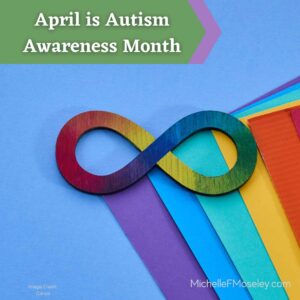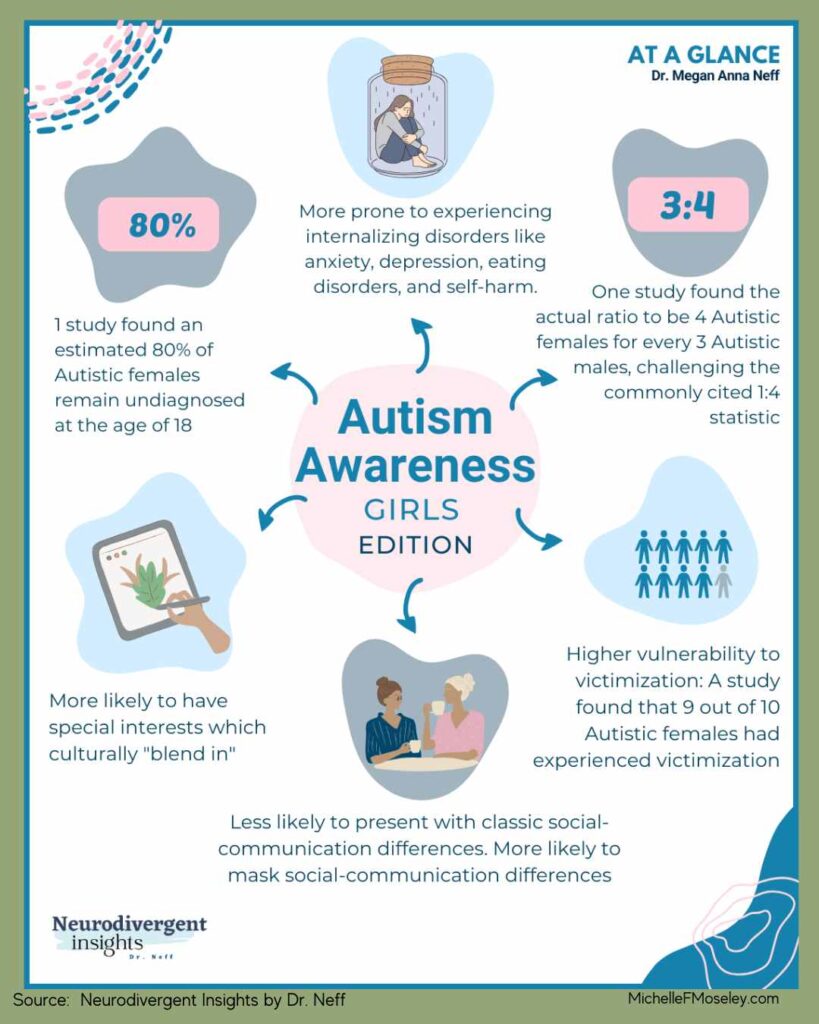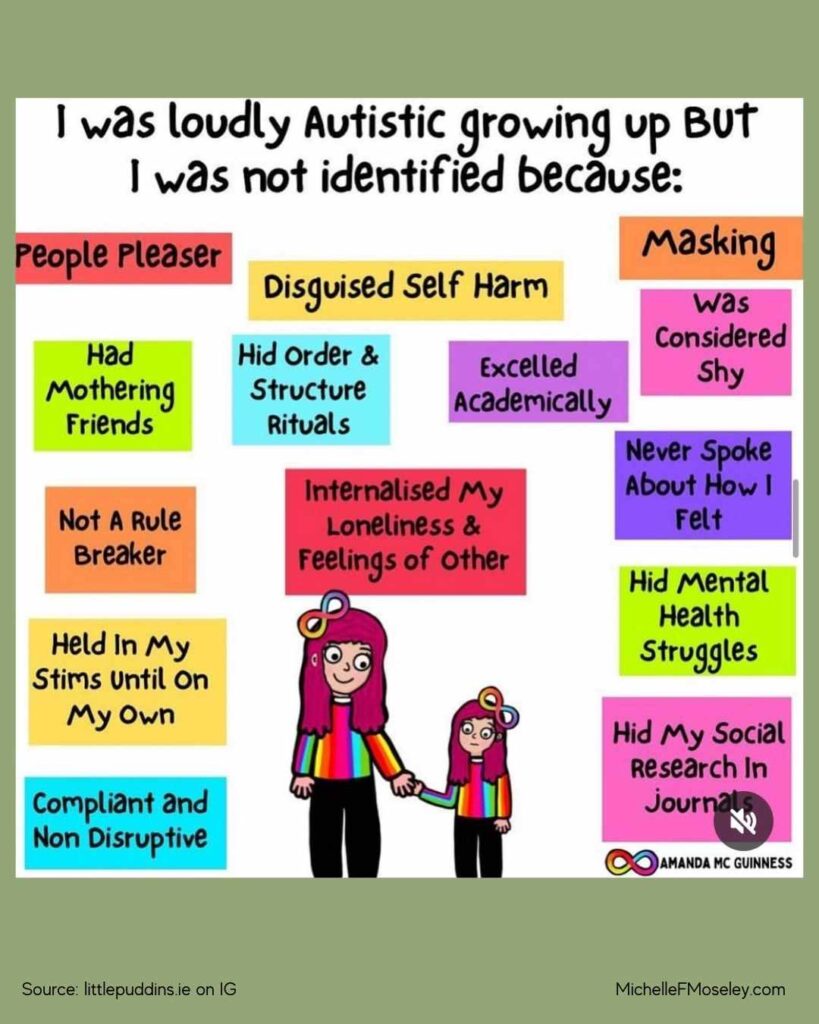April is Autism Awareness Month, or Autism Acceptance Month. Maybe a bit of both?
Both mental health professionals and society as a whole are becoming more aware of autism. More aware of the many ways that autistic folks may show up in the world. More aware of what autism is like for the person experiencing this particular neurodivergence, rather than only considering the impact of certain behaviors on the world around the autistic person.

So, yes, awareness of autism has increased over the past few decades. However, I’d say acceptance is still pretty lacking.

Why do I believe autism acceptance is lacking? Here are a few reasons:
- Autism is still labeled as a “disorder” in the DSM-5-TR (the book used to diagnose mental health, substance use, and developmental disorders). A diagnosis of “Autism Spectrum Disorder” is generally needed for someone to be eligible to receive accommodations they may need to thrive in an environment. This might include things like softer lighting options, the ability to move around while completing a task, or having both written and verbal instructions available. Yet, the word “disorder” doesn’t recognize that autistic brains are wired differently, but rather implies that the brains of autistic people are wrong (i.e. disordered).
- Many people’s picture of autism is a young, white boy who is non-verbal and “flails around.” This is an incredibly inaccurate and limiting view of autism. Autistic people are impacted in a variety of ways depending on exactly how their brain is wired. Some may be non-verbal, while others speak in front of 100s on a regular basis. Some autistic folks move their limbs in big ways – known as “stimming”, while others make much smaller movements that may not be noticeable to others – still known as “stimming.” While autism does not discriminate based on race, gender, or a myriad of other factors, the likelihood of access to accurate diagnosis certainly does. The picture of actually autistic people is far more varied than we’ve been led to believe.
- Getting an assessment and accurate diagnosis for autism isn’t accessible to many folks. The cost alone can be prohibitive – think at least $1,500, often not covered by insurance, and requiring months-long waitlists. The number of mental health professionals trained in diagnosing folks beyond childhood and/or those who have less support needs (i.e. appear to function well in the world without accommodations) is incredibly low. For example, I heard one late-diagnosed autistic woman sharing her experience of seeking diagnosis on a podcast. She talked about going into a room filled with child-size furniture and being handed a picture book and asked if she could construct a story. While this type of activity may be helpful in determining the needs of a child, it’s not an effective way to assess the needs of a grown woman who has achieved her PhD. Yet, that was the method of assessment available.
- Labels such as “high-functioning” or “low-functioning” abound and continue to be utilized by mental health professionals. These labels are ableist in that they are comparing an individual’s abilities and needs to some predetermined “ideal” way of functioning in the world, a way that does not cause any inconvenience for others. For at least 5 years, the more appropriate language has referred to an autistic individual’s needs – high support needs (needing more assistance or accommodations) or low support needs (needing fewer, or perhaps no, assistance or accommodations) – acknowledging every autistic individual is different.
- Folks make comments like “we’ve all got a bit of the “tism, don’t we?” No, no we don’t. We may all have a few quirks or particularities because that is part of being human. We do not all have a neurodivergent brain that impacts how we interact with the world in very particular ways.
These are just a few examples of reasons why I say that Autism Awareness has grown in recent years, while Autism Acceptance continues to lag behind.
My Own Neurodivergence
Autism Awareness / Acceptance Month hits a bit different for me this year, as I’m coming to terms with being a late identified autistic individual. I’ve had suspicions for 10+ years, but it has all come together in the past year.
It’s known in professional circles that autism has been less diagnosed in women, and in those assigned female at birth (AFAB). There are a variety of ideas about why this could be: the stereotypical view of autism as mentioned earlier, the tendency for more women and AFAB folks to be more adept at ‘reading the room’ and forcing themselves to meet expectations, the presence of more socially acceptable special interests, and the fact that women are just generally understudied within the medical community.

Like many folks who are late-identified or late-diagnosed, there is an ongoing battle of a few emotional reactions present:
- Relief because “Oh my goodness, that makes so much sense!” when I think back over various instances in my life.
- Anger because “I was told I was bad / wrong / sinful simply because my brain functions the way it does.”
- Grief because so many aspects of life have felt and do feel so incredibly difficult. As Patrick Casale has mentioned on his podcast (listed below in resources), I resonate with the feeling of being “a raw nerve exposed to the world” and everything is like sandpaper rubbing against me.
- Sadness for all the younger versions of me that were punished and given hurtful and dismissive labels for simply attempting to navigate a world that was/is non-sensical to my brain.

I resonate with many of the things mentioned in the image above, including: people pleaser, not a rule breaker, held in my stims, compliant and non-disruptive, excelled academically, was considered shy or stand-offish, and had mental health struggles.
I’m approaching this April with a much higher degree of Autism Awareness than in previous years, and continuing my own journey toward Autism Acceptance as it applies to my own experience.
Some Resources for Further Learning
DIVERGENT CONVERSATIONS. This podcast is hosted by 2 AuDHD therapists, Patrick Casale and Dr. Megan Neff, and is an excellent listen for anyone who desires to understand more about neurodivergence. The episodes may help you understand someone you care about, or recognize your own way of navigating a neurotypical world.
UNMASKING AUTISM. The book Unmasking Autism by Devon Price, PhD provides lots of information on understanding the ways that autism has been missed in many folks, including how race and gender have played a role in diagnosis.
EMBRACE-AUTISM WEBSITE. This website offers a lots of information and online assessments to help you understand more about autism. The assessments are well-researched, and information is provided about each one in easily-understandable language. These assessments may even be a starting point in figuring out if you or someone you care about is autistic because they provide a framework to understand and discuss your experience.
Michelle F. Moseley is a Licensed Mental Health Counselor in NC. She believes ALL people deserve respect, compassion, and access to mental and physical healthcare. Michelle specializes in working with survivors of religious trauma and with those who have body image concerns, finding there is frequent overlap in these areas. You can learn more about Michelle by visiting her website at MichelleFMoseley.com or following her on Instagram – @therapy_with_michelle
Sign-up for Michelle’s Monthly Email Newsletter to make sure you never miss a blog post
